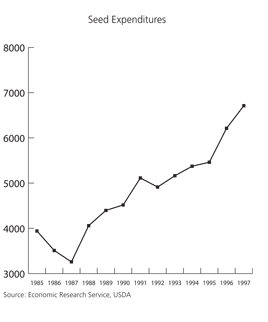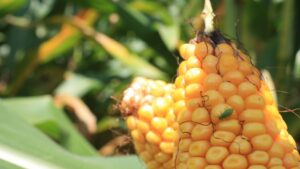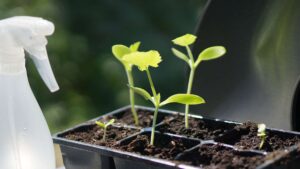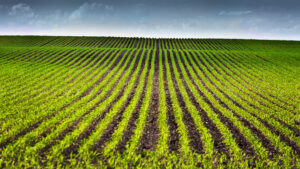Better genetics and improved traits have increased seed’s performance—at a cost.
The price of seed has increased steadily over the last 20 years, with significant increases in the last decade. In fact, prices paid for seeds have risen 146 percent since 1999. Today, it is not unheard of for seed with certain genetically modified traits to cost over $250 per bag, whereas 10 years ago premium seed cost about $80–100 per bag. And with more traits and bundling on the horizon, increases in seed costs are expected to continue.
Stacking Up
The biggest change accounting for the price increase of seed has been the introduction of multiple traits. The cost of seed corn with bundled traits was recently analyzed by a trio of economists from the University of Wisconsin, who looked at the price structure for seed corn around the U.S. Corn Belt from 2000 to 2007, particularly comparing the pricing of genetically modified bundled seed with conventional seed corn, while gauging the market power of the biotech firms.
Interestingly, the pricing information did not come from seed companies, but from over 38,000 farms in 48 states which bought seed in nearly 169,000 transactions. Research showed the biotech share of the seed corn market expanded from 27 percent in 2000 to over 74 percent in 2007.
The UW researchers also found that depending on the state, there is an automatic premium added, except for Kentucky. “Ordered from high to low premium, these states are: Nebraska ($7.50), Iowa ($7.00), Kansas ($6.86), Missouri ($6.31), Illinois ($5.96), Minnesota ($5.24), Colorado ($5.01), South Dakota ($4.75), Pennsylvania ($3.93), and Indiana ($3.70). This shows that the main corn-producing states in the Corn Belt charge more for corn seeds (e.g., Illinois or Iowa),” the report said.
Not surprisingly, the introduction of biotech varieties increased seed prices, but for both biotech and conventional seed. They also found that large farms pay more for seed, possibly due to the fact they are more productive and willing to pay more for high quality seed. Additionally, the average price rises about 2% per year, which is less than the inflation rate.
The WI trio examined seed corn pricing in Illinois in 2004 to illustrate how stacked traits were actually priced:
- Conventional seed corn averaged $88.33 per bag.
- The Bt corn borer trait added $20.49.
- The Bt rootworm trait was alone worth $27.28.
- One herbicide tolerant trait was priced at $14.51, another at $6.83.
- Double stacking of corn borer and rootworm traits added $35.51.
- Triple stacking of corn borer, rootworm and herbicide tolerance added $37.30.
- Quadruple stacking added $39.45 for corn borer, rootworm and both herbicide tolerant traits.
- The market power of the seed company added over 8 percent to the price.
“Pricing of the traits can become complex, and has rapidly increased over time, but has also allowed farmers to purchase combinations of seed with some degree of savings within a bundled trait package,” said the report summary.
As researchers and plant breeders unlock more yields from each bag of seed, prices will keep moving higher. But how high is too high? “One has to look at the whole package,” says Craig Dobbins, professor of agricultural economics at Purdue University. “It’s not just the seed being purchased, it’s a package of traits and genetics.”
The value of any trait, currently in the market or in the pipeline, will be driven by how much better it performs. In other words, there will need to be a yield advantage in order to justify a price increase.
And for now, it seems producers are willing to hand over the higher dollars to get the best hybrids. “In 2008, our highest-volume products were also the highest priced,” said Brian Humphries, vice president of sales and marketing for Wyffels Hybrids, in a Farm Industry News article. “Producers want these products. They want insect protection, they want herbicide tolerance, they want the service we provide. It’s easy, it’s safer and it works.”
By the Numbers
- Total seed expenditures by U.S. farmers rose from about $500 million in 1960 to over $6.7 billion in 1997.
- Ten years ago, typical seed corn prices fi t a range of about $75–$120 per bag. By the fall of 2007, the range was $115–$260. Seed costs for other major crops were also tracking higher in the 3–8 percent range annually.
- USDA fi gures show that corn seed prices have risen 135 percent since 2001. Soybean prices went up 108 percent over that period.
- Since 1999, prices paid for seeds have risen 146 percent, with 64 percent of that rise occurring during 2007–2009.
- Seed corn costs per acre have increased, on average, from $24 an acre in 1993 to $51 an acre in 2007.
- Following an increase of $2.5 billion (20 percent) in 2008, seed expenses rose $400 million (2.6 percent) in 2009.
Related news article published November 1, 2010: Are higher corn prices needed? Click here for more information.














